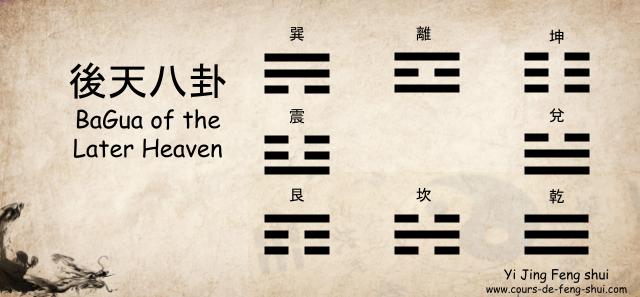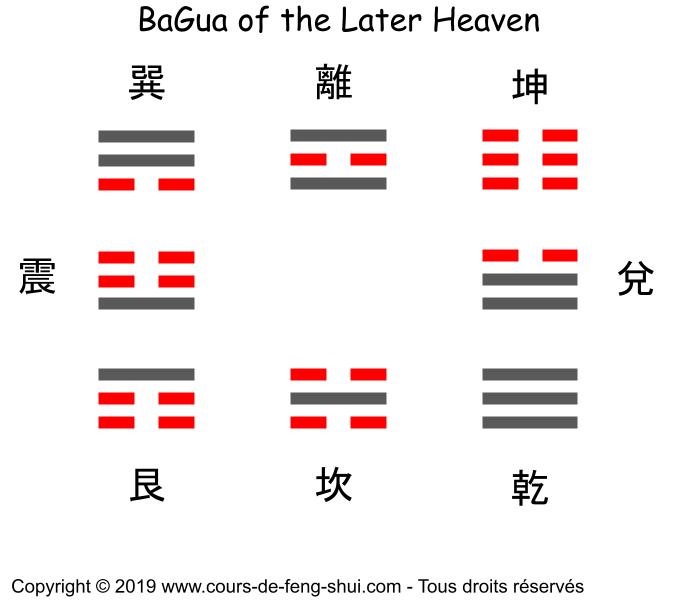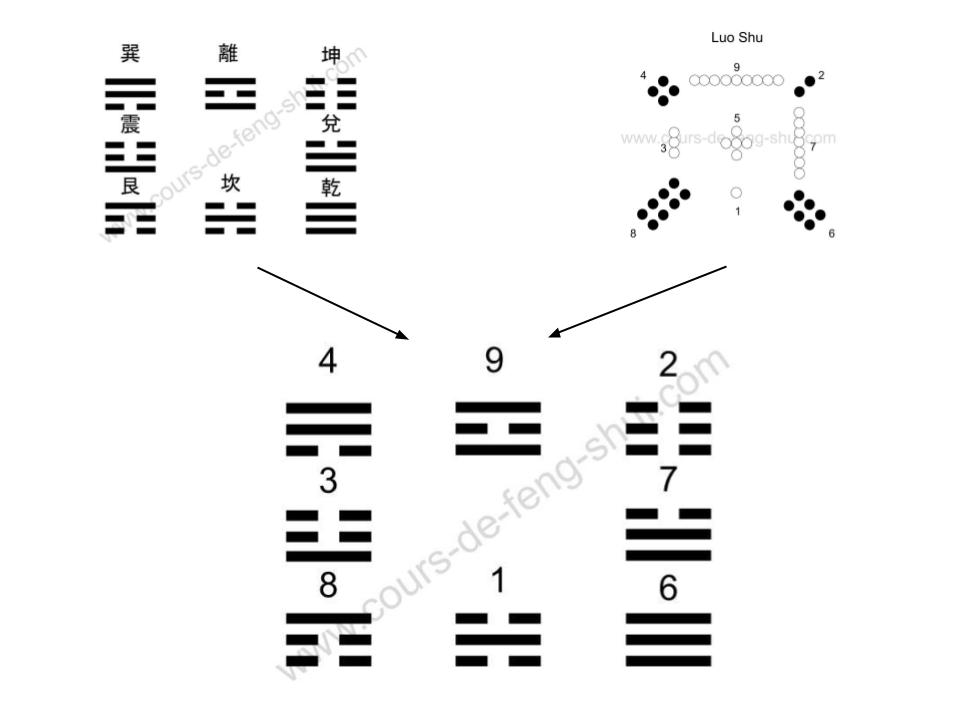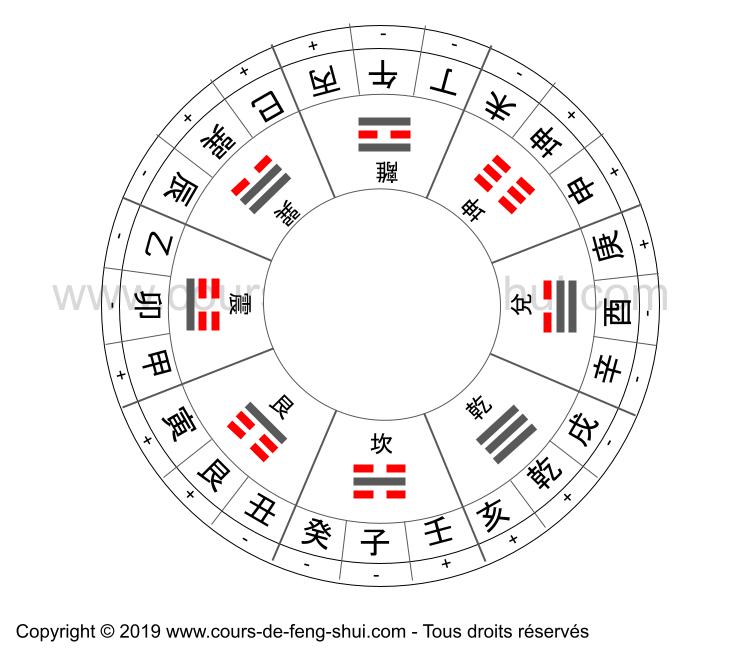
The BaGua of the Later Heaven is a powerful symbol in Chinese metaphysics, representing the structure of the universe after its creation. This version of the BaGua reflects a world in motion—incorporating concepts of time, space, and dynamic interactions. It’s often used in Feng Shui, Bazi, Qi Men Dun Jia, and Yijing divination for practical applications.
Origins of the BaGua of the Later Heaven
The arrangement of the eight trigrams (symbols representing natural forces) in the Later Heaven sequence is attributed to King Wen Wang (circa 1000 BCE). This version is sometimes called the “BaGua of King Wen.” It is said that the Later Heaven BaGua is derived from the Luo Shu, a mystical diagram.
In contrast to the theoretical arrangement of the trigrams in the Earlier Heaven (attributed to Fu Xi), King Wen’s Later Heaven arrangement focuses on practical use in the material world.
What Does “BaGua of the Later Heaven” Mean?
- 後天 (Hòu Tiān): Meaning “Later Heaven” or “after the sky,” referring to the state of the universe after its creation.
- 八卦 (Bā Guà): Meaning “eight trigrams,” referring to the eight fundamental forces of nature.
In Chinese, the phrase 後天八卦 (Hòu tiān bā guà) is used to describe this cosmic order.

The Arrangement of the 8 Trigrams in the Later Heaven
In the Later Heaven sequence, the trigrams are arranged in a circle and are read clockwise, starting from the Zhen trigram:
- Gen ☶ (Earth): Northeast
- Zhen ☳ (Wood): Associated with the East
- Xun ☴ (Wood): Southeast
- Li ☲ (Fire): South
- Kun ☷ (Earth): Southwest
- Dui ☱ (Metal): West
- Qian ☰ (Metal): Northwest
- Kan ☵ (Water): North

Connection to the Luo Shu and Five Elements
The BaGua of the Later Heaven is closely related to the Luo Shu diagram. By superimposing the BaGua over the Luo Shu, you can observe how Yin-Yang, the Five Elements (Wood, Fire, Earth, Metal, Water), and seasonal directions align.
The Trigrams and Their Elemental Associations:
- Zhen ☳: Wood
- Xun ☴: Wood
- Li ☲: Fire
- Kun ☷: Earth
- Dui ☱: Metal
- Qian ☰: Metal
- Kan ☵: Water (North)
- Gen ☶: Earth
Each trigram in the Later Heaven BaGua corresponds to a specific direction, element, and natural force.
The Luo Shu Numbers and the 8 Trigrams
In addition to the elemental and directional associations, the trigrams in the Later Heaven BaGua are linked to numbers in the Luo Shu diagram, which is used in Feng Shui and divination practices:
- Kan ☵: Number 1 (Water, Yang)
- Kun ☷: Number 2 (Earth, Yin)
- Zhen ☳: Number 3 (Wood, Yang)
- Xun ☴: Number 4 (Wood, Yin)
- Qian ☰: Number 6 (Metal, Yang)
- Dui ☱: Number 7 (Metal, Yin)
- Gen ☶: Number 8 (Earth, Yin)
- Li ☲: Number 9 (Fire, Yang)
The BaGua and Directions in Feng Shui
The Later Heaven BaGua also plays a significant role in Feng Shui. It helps determine auspicious directions, as each trigram represents a direction on the compass:
- Zhen ☳ East
- Xun ☴ Southeast
- Li ☲ South)
- Kun ☷ Southwest
- Dui ☱ West
- Qian ☰ Northwest
- Kan ☵ North
- Gen ☶ Northeast

The 24 Mountains and the BaGua
In traditional Feng Shui, the 24 mountains are a system that divides the compass into 24 segments. Each of these mountains is aligned with a trigram, Heavenly Stem, or Earthly Branch:
- Kan ☵ (North): 壬 (Ren), 子 (Zi), 癸 (Gui)
- Gen ☶ (Northeast): 丑 (Chou), 艮 (Gen), 寅 (Yin)
- Zhen ☳ (East): 甲 (Jia), 卯 (Mao), 乙 (Yi)
- Xun ☴ (Southeast): 辰 (Chen), 巽 (Xun), 巳 (Si)
- Li ☲ (South): 丙 (Bing), 午 (Wu), 丁 (Ding)
- Kun ☷ (Southwest): 未 (Wei), 坤 (Kun), 申 (Shen)
- Dui ☱ (West): 庚 (Geng), 酉 (You), 辛 (Xin)
- Qian ☰ (Northwest): 戌 (Xu), 乾 (Qian), 亥 (Hai)
Practical Applications of the Later Heaven BaGua
The Later Heaven BaGua is essential for practical applications in Feng Shui, divination, and metaphysical studies. Whether determining auspicious directions, understanding natural forces, or applying elemental theory, the Later Heaven BaGua provides a roadmap for understanding the universe’s post-creation dynamics.